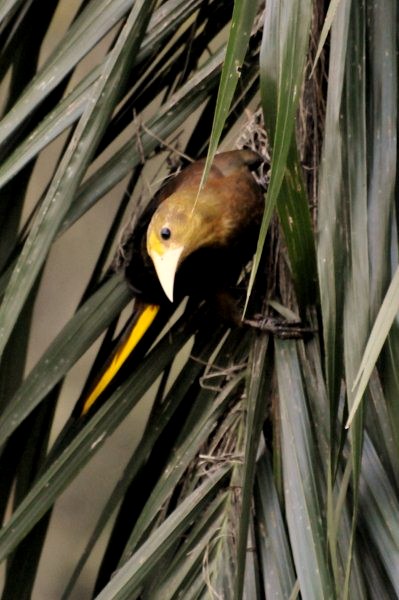Oropendola

|
The Amazonian
Oropendola
The Amazonian Oropendola (Psarocolius bifasciatus) is both the largest member of the Icterid family and the largest passerine bird in South America. It is sometimes placed in the genus Gymnostinops instead of Psarocolius. As suggested by its name, it is found widely – but often in low densities – throughout humid lowland forests of the Amazon Basin, with the notable exception of most of the Guiana Shield. It is sometimes split into two species, the western Olive Oropendola (P. yuracares) and the eastern Pará Oropendola (P. bifasciatus), but the subspecies P. y. neivae is widely recognized as a hybrid swarm, and the vast majority of authorities consider them a single species.
 Description: The sexes of this icterid are very different in size: the male is twenty one inches long and weighs one and a bit pounds; the smaller female is sixteen inches long and weighs nine and a bit ounces. Confusingly, the name "Olive Oropendola" has sometimes been used for this combined species, despite the fact that the nominate subspecies has no olive to its plumage, as its head and chest are black (these are olive in P. b. yuracares). The back, wings and belly of this large oropendola are brown, the outer rectrices are yellow (i.e. tail appears all yellow from below), the bare facial skin is pink, the eyes are brown, and the bill is black with an orange tip. The superficially similar Green Oropendola has an olive back and wing-coverts, lacks extensive bare facial-skin, has a pale bill with an orange tip, and blue eyes.
The beginnings of a nest. The bird shreds some leaves to begin the weaving process. The nests last only one breeding year and fall during the rainy season
Behaviour: The Amazonian Oropendola is a canopy bird that most often is seen flying high over the tops of the trees. Compared to other oropendolas it is a "loner" most frequently seen alone or in pairs, and drawing less attention to itself than its cousins, despite the greater size. Small groups are seen occasionally, and may even mix with other oropendolas. The breeding colonies are small, usually with fewer than five birds. The nest is a hanging woven ball fibres and vines, sixty to one hundred and eighty centimeters long, high in a tree. Relatively little is known about these bird's breeding habits.
  The omnivorous diet appears to be fairly catholic, with small vertebrates, large insects, amphibians, reptiles, nectar, and fruit. They often travel great distances through the forests, except when lingering around their nesting colony.
 The song of the Amazonian Oropendola is a liquid, gurgling and "expanding" stek-ek-ek-ek-eh-eh-eh-o'o 'GLOOP’ actually sounds like a huge toad, given as a displaying male falls forward on a perch and rustles his wings over the back. Nasal raap and whrup calls are given while in flight or when foraging.
 
This chap had been on the nest and spent ages having a really good preen and scratch
Meanwhile his wife went to nesting duties
ALL IN ALL INCREDIBLE TO WATCH THESE BIRDS UP CLOSE AND PERSONAL |




